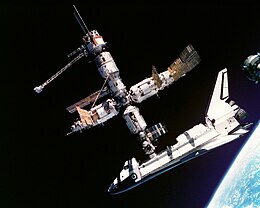 Atlantis docked to Mir, photographed from the departing Soyuz-TM spacecraft Uragan | |
| Names | Space Transportation System-71 |
|---|---|
| Mission type | Shuttle-Mir |
| Operator | NASA |
| COSPAR ID | 1995-030A |
| SATCAT no. | 23600 |
| Mission duration | 9 days, 19 hours, 23 minutes, 9 seconds |
| Distance travelled | 6,600,000 kilometres (4,100,000 mi) |
| Orbits completed | 153 |
| Spacecraft properties | |
| Spacecraft | Space Shuttle Atlantis |
| Payload mass | 12,191 kilograms (26,877 lb) |
| Crew | |
| Crew size | 7 up 8 down |
| Members | |
| Launching | |
| Landing | |
| Start of mission | |
| Launch date | June 27, 1995, 19:32:19 UTC |
| Launch site | Kennedy, LC-39A |
| End of mission | |
| Landing date | July 7, 1995, 14:55:28 UTC |
| Landing site | Kennedy, SLF Runway 15 |
| Orbital parameters | |
| Reference system | Geocentric |
| Regime | Low Earth |
| Perigee altitude | 342 kilometres (213 mi) |
| Apogee altitude | 342 kilometres (213 mi) |
| Inclination | 51.6 degrees |
| Period | 88.9 min |
| Docking with Mir | |
| Docking port | Kristall forward |
| Docking date | June 29, 1995, 13:00:16 UTC |
| Undocking date | July 4, 1995, 11:09:42 UTC |
| Time docked | 4 days, 22 hours, 9 minutes 26 seconds |

 Left to right – Seated: Dezhurov, Gibson, Solovyev; Standing: Thagard, Strekalov, Harbaugh, Baker, Precourt, Dunbar, Budarin | |
As the third mission of the US/Russian Shuttle-Mir Program, STS-71 became the first Space Shuttle to dock with the Russian space station Mir. STS-71 began on June 27, 1995, with the launch of Space Shuttle Atlantis from launchpad 39A at the Kennedy Space Center in Florida. The Shuttle delivered a relief crew of two cosmonauts Anatoly Solovyev and Nikolai Budarin to the station and recovered Increment astronaut Norman Thagard. Atlantis returned to Earth on July 7 with a crew of eight. It was the first of seven straight missions to Mir flown by Atlantis, and the second Shuttle mission to land with an eight-person crew after STS-61-A in 1985.
For the five days the Shuttle was docked to Mir they were the largest spacecraft in orbit at the time. STS-71 marked the first docking of a Space Shuttle to a space station, the first time a Shuttle crew switched members with the crew of a station, and the 100th crewed space launch by the United States. The mission carried Spacelab and included a logistical resupply of Mir. Together the Shuttle and station crews conducted various on-orbit joint US/Russian life science investigations with Spacelab along with the Shuttle Amateur Radio Experiment-II (SAREX-II) experiment.